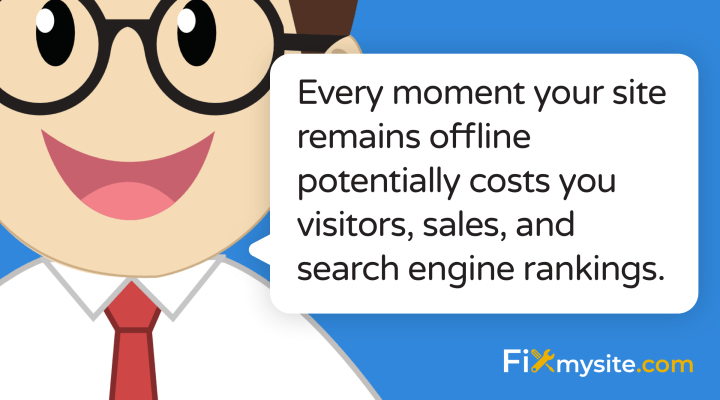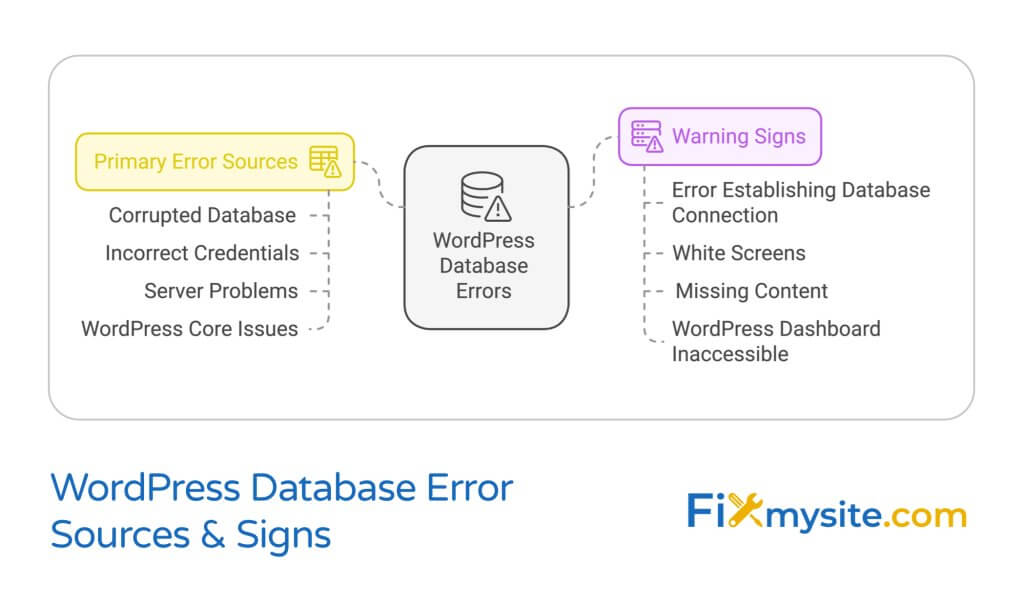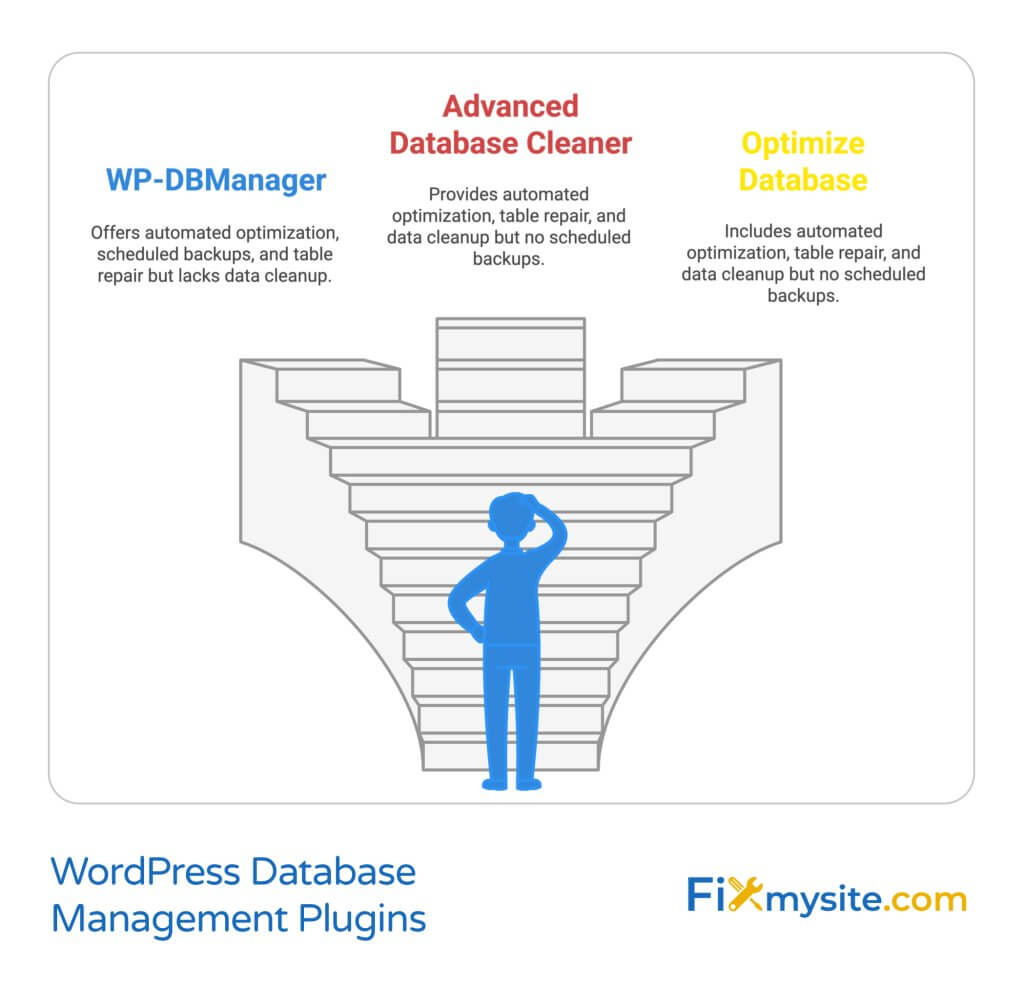
Database errors can bring your WordPress site to a complete standstill, disrupting your business operations and potentially losing valuable customers.
Incorrect database credentials stand as the most frequent cause of these frustrating connection errors (Source: MainWP).
Take a deep breath – we’ll guide you through proven solutions to get your site back online quickly.
Your WordPress database serves as the foundation of your entire website, storing everything from posts and pages to crucial configuration settings. When database errors strike, they can manifest as blank screens, connection failures, or even complete site outages. Fortunately, most database issues have straightforward solutions that you can implement right away.
Whether you’re facing the dreaded “Error Establishing a Database Connection” message or dealing with corrupted tables, our WordPress maintenance checklist approach will help restore your site’s functionality. These solutions work across different hosting environments and WordPress versions, ensuring you can fix the problem regardless of your technical setup.
Database errors often strike at the worst possible moments, but our emergency WordPress solutions will help you navigate through this challenging situation. We’ll start with the simplest fixes and progress to more advanced solutions, ensuring you have all the tools needed to resolve your database issues.
Understanding WordPress Database Errors
WordPress database errors typically stem from four primary sources. A corrupted database, often resulting from plugin conflicts, failed updates, or server crashes, ranks among the most common causes (Source: MainWP). Understanding these root causes helps pinpoint the most effective solution for your specific situation.

Common Signs of Database Problems
Your WordPress site communicates database issues through specific error messages and behaviors. The most frequent indicator appears as the “Error Establishing a Database Connection” message. Other signs include white screens, missing content, or inability to log into your WordPress dashboard.
Database errors can affect different parts of your site in various ways. Front-end visitors might see error messages or blank pages, while administrators could lose access to the WordPress dashboard. These symptoms often indicate problems with your WordPress database connection.
Primary Causes of Database Errors
- Incorrect Credentials: Mismatched database name, username, password, or host information in your configuration files
- Corrupted Tables: Database tables damaged during updates or due to server issues
- Server Problems: High traffic volumes, resource limitations, or hosting maintenance
- WordPress Core Issues: Corrupted core files affecting database connectivity
The impact of database errors extends beyond mere inconvenience. Every moment your site remains offline potentially costs you visitors, sales, and search engine rankings. Quick identification of the underlying cause enables faster resolution and minimizes downtime impact on your business.
Impact on Website Functionality
Database errors disrupt core WordPress functions essential for your site’s operation. Content management, user authentication, and plugin functionality all depend on stable database connections. Understanding this interconnection helps emphasize the importance of maintaining proper database health through regular WordPress maintenance.
Before implementing any fixes, creating a backup of your current database provides crucial protection against potential data loss. This safety measure ensures you can restore your site’s data if troubleshooting steps cause unexpected issues.
1. Verifying Database Credentials
Checking your database credentials offers the quickest path to resolving connection errors. Incorrect database settings in your wp-config.php file represent the most common fixable issue for WordPress database errors (Source: SKT Themes).
Let’s walk through the verification process step by step.
Locating Your wp-config.php File
Your wp-config.php file resides in your WordPress installation’s root directory. Access this file through your hosting control panel’s file manager or via FTP. Always create a backup copy before making any changes to this critical file.
The database connection details appear near the top of wp-config.php, typically after the initial comments. Look for these four crucial settings:
- DB_NAME – Your database name
- DB_USER – Your database username
- DB_PASSWORD – Your database password
- DB_HOST – Your database host (usually ‘localhost’)
Verifying Credentials Accuracy
Compare these settings with your hosting control panel’s database information. Access your hosting dashboard and locate the MySQL Databases or Database Management section. This area displays your actual database credentials for verification.
Common credential mistakes include:
- Copying extra spaces before or after credentials
- Using outdated passwords after hosting changes
- Incorrect database host specifications
- Case sensitivity errors in database names or usernames
Making Secure Corrections
If you discover mismatched credentials, update your wp-config.php file with the correct information. Use a secure text editor to avoid introducing formatting errors or special characters. After saving changes, test your site to verify the connection.
⚠️ Security Note: Always use strong, unique passwords for your database credentials. Avoid common phrases or easily guessable combinations. Consider implementing our WordPress security checklist for comprehensive protection.
Testing the Connection
After updating credentials, clear your browser cache and reload your website. A successful fix results in normal site operation. If errors persist, document the exact error message – this information helps identify whether credential verification solved the issue or if you need to explore other solutions.
Sometimes, database connection issues stem from temporary hosting problems rather than credential mismatches. If your credentials appear correct but problems persist, prepare to explore additional troubleshooting steps in the following sections.

2. Using WordPress Built-in Repair Tools
WordPress includes powerful built-in database repair functionality, particularly useful when dealing with corrupted tables. Advanced users often utilize WP-CLI with the ‘wp db repair’ command for efficient database maintenance (Source: Kinsta).
However, we’ll focus on the user-friendly method accessible to everyone.
Enabling the Repair Tool
Access your wp-config.php file again and add the following line of code just before the line that says “/* That’s all, stop editing! */”:
define('WP_ALLOW_REPAIR', true);This code activates WordPress’s built-in database repair functionality. After adding this line, save the file and upload it back to your server if you’re using FTP.
Accessing the Repair Interface
With the repair functionality enabled, visit the following URL in your web browser:
http://your-website.com/wp-admin/maint/repair.phpReplace “your-website.com” with your actual domain name. This page presents two options:
- Repair Database: Fixes corrupted tables while preserving all data
- Repair and Optimize Database: Repairs tables and optimizes their structure for better performance
⚠️ Important: Create a complete WordPress backup before proceeding with any database repairs. While the repair process is generally safe, having a backup provides essential protection against unexpected issues.
Running the Repair Process
Select your preferred repair option and click the button to begin. The process automatically checks each database table, identifying and fixing any corrupted data it encounters. The repair tool displays real-time progress and results for each table it examines.
Common issues the repair tool addresses include:
- Corrupted table indexes
- Damaged data structures
- Incomplete database operations
- Table optimization issues
Post-Repair Security
After completing the repair process, immediately return to wp-config.php and remove the WP_ALLOW_REPAIR line. This crucial step prevents unauthorized access to the repair tool. Your database repairs remain in effect even after removing this line.
Monitor your site’s functionality after the repair. If you chose the optimization option, you might notice improved performance in areas like:
- Page load times
- Database query efficiency
- Overall site responsiveness
- Admin panel operations
If database issues persist after using the built-in repair tool, you may need more specialized solutions. Our next section covers using phpMyAdmin for more detailed database management.
3. Implementing phpMyAdmin Solutions
phpMyAdmin provides direct database access for more thorough repairs and optimization. Regular database maintenance prevents performance issues caused by fragmented tables (Source: Kinsta). This powerful tool offers precise control over your database structure and content.
Accessing phpMyAdmin
Most hosting providers include phpMyAdmin in their control panel. Look for the phpMyAdmin icon or database management section in your hosting dashboard. After accessing phpMyAdmin, select your WordPress database from the left sidebar.
⚠️ Caution: phpMyAdmin provides direct database access. Create a complete database backup before proceeding with any changes. One wrong move could affect your entire website.
Table Repair Process
Once inside your database, follow these careful steps to repair tables:
- Select all tables by checking the “Check All” box at the bottom
- Choose the “With selected:” dropdown menu
- Select “Repair table” from the available options
- Review the repair results for each table
Optimization Techniques
After repairing tables, optimize them to improve performance:
- Table Optimization: Select all tables and choose “Optimize table” from the dropdown
- Index Management: Check and repair table indexes for better query performance
- Storage Engine Verification: Ensure tables use the correct MySQL storage engine (usually InnoDB)
Advanced Troubleshooting
phpMyAdmin offers additional tools for complex database issues:
- SQL query execution for manual repairs
- Table structure analysis
- Data consistency checks
- Character set verification
Monitoring Results
After completing repairs and optimization, monitor these aspects:
- Table status indicators (look for “OK” status)
- Database size and structure
- Query performance improvements
- Overall site responsiveness
Sometimes, managing database issues requires ongoing attention. Consider implementing our WordPress care plan for regular database maintenance and optimization.
Safety Measures
Protect your database work by following these essential practices:
- Document all changes made in phpMyAdmin
- Keep backup files easily accessible
- Test website functionality after each major change
- Monitor error logs for potential issues
If phpMyAdmin seems too technical or you’re uncomfortable making direct database changes, database management plugins offer a more user-friendly alternative, which we’ll explore in the next section.
4. Database Management Plugin Solutions
While plugin conflicts can potentially cause database connection errors (Source: ThePlusAddons), properly chosen database management plugins actually simplify maintenance and repair tasks. These tools provide user-friendly interfaces for database optimization without requiring technical expertise.

Selecting the Right Plugin
When choosing a database management plugin, focus on these essential features:
- Automated repair capabilities
- Scheduled optimization tools
- Backup functionality
- User-friendly interface
Popular Database Management Plugins
Several reliable plugins offer comprehensive database management features. Here’s what each one excels at:
| Feature | WP-DBManager | Advanced Database Cleaner | Optimize Database |
|---|---|---|---|
| Automatic Optimization | ✓ | ✓ | ✓ |
| Scheduled Backups | ✓ | – | – |
| Table Repair | ✓ | ✓ | ✓ |
| Data Cleanup | – | ✓ | ✓ |
Implementation Steps
Follow these steps to implement a database management plugin:
- Install the plugin through WordPress’s plugin directory
- Activate and configure basic settings
- Run initial database optimization
- Set up automated maintenance schedules
⚠️ Safety First: Before running any plugin operations, connect with our WordPress maintenance guidelines to ensure proper backup procedures.
Optimization Best Practices
Maximize plugin effectiveness by following these guidelines:
- Schedule optimizations during low-traffic periods
- Monitor database size changes after optimization
- Keep plugin software updated
- Review optimization logs regularly
Plugin Limitations
Understand what database plugins can and cannot do:
Can Do:
- Optimize table structure
- Remove unnecessary data
- Schedule maintenance tasks
- Provide performance reports
Cannot Do:
- Fix corrupt WordPress core files
- Resolve server-side issues
- Repair damaged file systems
- Fix hosting configuration problems
While plugins offer valuable maintenance tools, some database issues require server-level intervention.
5. Resolving Server-Related Issues
Server problems, particularly during high traffic periods, frequently trigger the “Error Establishing Database Connection” message (Source: SKT Themes). Understanding and addressing these server-level challenges proves crucial for maintaining stable database connections.
Identifying Server Problems
Common server-related database issues manifest through these indicators:
- Intermittent connection failures
- Slow database responses
- Resource limit warnings
- CPU usage spikes
⚠️ Critical Note: If you notice sudden performance changes, check your WordPress speed optimization settings before assuming database problems.
Working with Hosting Providers
Effectively communicate with your hosting provider by following these steps:
- Document specific error messages and timestamps
- Request server logs for the error period
- Ask about recent server maintenance or updates
- Discuss resource allocation and limits
Traffic Management Solutions
Implement these strategies to handle high-traffic situations:
Caching Solutions:
- Enable database query caching
- Implement page caching
- Use object caching when available
Resource Optimization:
- Monitor database connection limits
- Optimize query performance
- Implement load balancing if necessary
Server Configuration Optimization
Request these server-side adjustments from your hosting provider:
- Increase PHP memory limits
- Optimize MySQL settings
- Adjust max_connections value
- Configure proper timeout settings
Monitoring and Prevention
Implement these monitoring practices to prevent future server-related issues:
- Set up server resource monitoring
- Track database performance metrics
- Monitor error logs regularly
- Implement early warning systems
Consider upgrading to our WordPress care package for proactive server monitoring and maintenance.
Emergency Response Plan
Prepare for server emergencies by establishing these protocols:
- Maintain current backup copies
- Document emergency contact procedures
- Create a traffic overflow plan
- Establish failover procedures
Sometimes, server issues can corrupt WordPress core files, leading to database connection problems. Let’s explore how to address these corrupted files in our next section.
6. Restoring WordPress Core Files
Corrupted WordPress core files often trigger database connection errors, necessitating a fresh file upload to restore functionality (Source: MainWP). This restoration process requires careful attention to preserve your existing content while replacing damaged system files.
Preparing for Core File Restoration
Before beginning the restoration process, secure your site with these essential steps:
- Create a complete backup of your current installation
- Download a fresh copy of WordPress from WordPress.org
- Document any custom file modifications
- Note all active plugins and themes
⚠️ Critical Warning: Never skip creating a WordPress backup before attempting core file restoration. This safeguard protects against unexpected complications during the process.
Core File Replacement Process
Follow these steps to safely replace corrupted core files:
- Access Your Server:
- Connect via FTP or file manager
- Navigate to your WordPress root directory
- Verify connection stability
- Preserve Custom Content:
- Identify wp-content directory
- Save custom themes and plugins
- Backup wp-config.php file
- Replace Core Files:
- Upload fresh WordPress files
- Maintain existing wp-config.php
- Preserve wp-content directory
Post-Restoration Verification
Verify successful restoration by checking these elements:
- Database connectivity
- Admin panel access
- Theme functionality
- Plugin operations
Common Restoration Challenges
Be prepared to address these potential issues:
Permission Problems:
- File ownership conflicts
- Directory access restrictions
- Upload permissions
Configuration Issues:
- PHP version compatibility
- Server setting conflicts
- Database connection parameters
Preventive Measures
Implement these practices to prevent future core file corruption:
- Maintain regular backup schedules
- Monitor file integrity
- Update WordPress core promptly
- Verify plugin compatibility
Consider implementing our emergency WordPress solutions for faster recovery from future file corruption issues.
While restoring core files often resolves database connection issues, sometimes the problem lies with database size limits. Let’s explore how to manage these limitations in our next section.
7. Managing Database Limits
Database space issues often emerge when accumulated backups, temporary files, and plugin data consume available storage (Source: MrPerfectGuide). Understanding and managing these limitations prevents unexpected downtime and maintains optimal site performance.
Understanding Database Limits
Database limits affect your WordPress site in several ways:
- Storage space allocation
- Maximum connection numbers
- Query execution time
- Table size restrictions
⚠️ Resource Alert: Monitor your WordPress performance metrics regularly to catch database limit issues before they become critical.
Monitoring Database Size
Track these key metrics to prevent database overflow:
| Metric | Warning Sign | Action Needed |
|---|---|---|
| Total Size | Approaching host limit | Cleanup or upgrade |
| Growth Rate | Rapid increase | Identify source |
| Table Sizes | Disproportionate growth | Optimize specific tables |
Optimization Strategies
Implement these techniques to manage database size effectively:
Regular Cleanup:
- Remove post revisions
- Clear spam comments
- Delete unused themes
- Clean transient options
Data Management:
- Archive old content
- Optimize media storage
- Manage plugin data
- Schedule regular cleanups
Hosting Plan Considerations
Evaluate these factors when assessing your hosting plan:
- Current usage patterns
- Growth projections
- Traffic fluctuations
- Backup requirements
Consider our WordPress care packages for automated database management and optimization.
Emergency Space Recovery
When facing immediate space issues, follow these steps:
- Identify largest database tables
- Remove unnecessary data
- Optimize table structures
- Clear temporary storage
Long-term Management
Establish these practices for ongoing database health:
- Regular size monitoring
- Automated cleanup schedules
- Growth trend analysis
- Capacity planning
Proper database management requires ongoing attention and maintenance. Let’s explore preventive measures to avoid future database issues in our final section.
Preventing Future Database Issues
Regular database optimization prevents performance degradation caused by fragmented tables and outdated data (Source: Kinsta). Implementing a proactive maintenance strategy helps avoid common database problems before they impact your site.
Essential Maintenance Schedule
Create a comprehensive maintenance routine that includes:
Daily Tasks:
- Monitor error logs
- Check database connectivity
- Verify backup completion
Weekly Tasks:
- Optimize database tables
- Review performance metrics
- Clean temporary data
Monthly Tasks:
- Full database optimization
- Security audit
- Resource usage review
⚠️ Prevention Tip: Implement our WordPress maintenance checklist to ensure consistent database health monitoring.
Backup Strategy Implementation
Establish a robust backup system with these components:
- Automated daily backups
- Multiple backup locations
- Version retention policy
- Regular restoration testing
Performance Monitoring
Track these critical metrics to maintain optimal database performance:
| Metric | Normal Range | Action Trigger |
|---|---|---|
| Query Response Time | < 1 second | Optimization needed |
| Database Size | < 80% capacity | Cleanup required |
| Error Frequency | < 0.1% | Investigation needed |
Best Practices for Prevention
Follow these guidelines to maintain database health:
Plugin Management:
- Regular updates
- Remove unused plugins
- Verify compatibility
- Monitor resource usage
Content Management:
- Limit post revisions
- Optimize media files
- Clean comment spam
- Archive old content
Security Measures
Implement these security practices to protect your database:
- Strong password policies
- Regular security scans
- Access limitation
- Activity monitoring
Consider our comprehensive WordPress care packages for automated maintenance and security monitoring.
Documentation Requirements
Maintain detailed records of:
- Configuration changes
- Maintenance activities
- Error occurrences
- Performance trends
With these preventive measures in place, you’ll significantly reduce the risk of database issues. Let’s address some common questions in our FAQ section.
Frequently Asked Questions
How often should I optimize my WordPress database?
Regular database optimization should occur weekly for active websites. High-traffic sites might require more frequent optimization, while smaller sites can maintain monthly schedules. Monitor your site’s performance to determine the ideal frequency for your specific situation.
What causes WordPress database corruption?
Database corruption typically occurs due to several factors, including plugin conflicts, failed updates, or server crashes (Source: MainWP). Regular maintenance and proper backup procedures help prevent these issues.
Can I fix database errors without technical knowledge?
Yes, many database issues can be resolved using WordPress’s built-in repair tools or user-friendly plugins. However, for complex problems, consider professional WordPress maintenance services to ensure proper resolution.
How do I know if my database needs repair?
Common signs include:
- Error establishing database connection messages
- Slow website performance
- Missing or corrupted content
- White screen of death
Will repairing the database delete my content?
No, proper database repair procedures preserve your content. However, always create a backup before performing any database operations to protect against unexpected issues.
What should I do if the built-in repair tool doesn’t work?
If the built-in repair tool fails, try these alternatives:
- Use phpMyAdmin for manual repairs
- Implement a database management plugin
- Restore from a recent backup
- Contact your hosting provider for assistance
How can I prevent future database errors?
Implement these preventive measures:
- Regular backups
- Scheduled optimization
- Update WordPress core, themes, and plugins
- Monitor database size and performance
Should I upgrade my hosting plan if I experience frequent database errors?
Consider upgrading if you consistently encounter database errors related to resource limitations or if your site experiences high traffic volumes. Consult our emergency WordPress solutions for immediate assistance.
Need Professional Database Management?
Don’t let database errors impact your business. Our expert team provides comprehensive WordPress maintenance and support services to keep your site running smoothly. Contact us for professional assistance.


